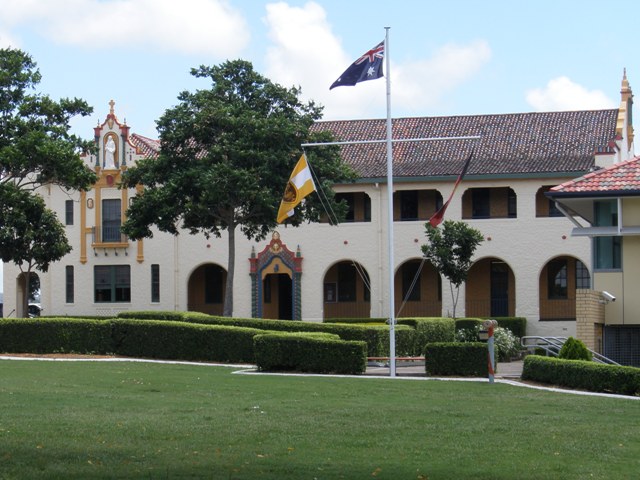Addresses
Type of place
Residence (group), Institutional / group housing, Private school
Period
Interwar 1919-1939, World War II 1939-1945
Style
Spanish Mission
Addresses
Type of place
Residence (group), Institutional / group housing, Private school
Period
Interwar 1919-1939, World War II 1939-1945
Style
Spanish Mission
The former Franciscan Friary was built between 1930 and 1941 as the Franciscan Friars took responsibility for the Catholic parish in Kedron. The first section of the friary designed by Hennessy, Hennessy & Co. was opened in June 1930 by Archbishop Duhig. A fine example of a substantial Spanish Mission style building, the former friary is now the administrative hub of Padua College.
Also known as
Padua College
Lot plan
L1_SP242815
Key dates
Local Heritage Place Since —
Date of Citation —
Construction
Roof: Terracotta tile;Walls: Masonry - Stucco
People/associations
Archbishop Duhig (Association);Hennessy, Hennessy & Co. (Architect)
Criterion for listing
(A) Historical; (B) Rarity; (D) Representative; (E) Aesthetic; (F) Technical; (G) Social; (H) Historical associationInteractive mapping
Also known as
Padua College
Lot plan
L1_SP242815
Key dates
Local Heritage Place Since —
Date of Citation —
Construction
Roof: Terracotta tile;Walls: Masonry - Stucco
People/associations
Archbishop Duhig (Association);Hennessy, Hennessy & Co. (Architect)
Criterion for listing
(A) Historical; (B) Rarity; (D) Representative; (E) Aesthetic; (F) Technical; (G) Social; (H) Historical associationInteractive mapping
History
The Kedron Catholic congregation was formed under the patronage of Saint Terese of Lisieux (The Little Flower) in 1923 as part of the Wooloowin parish. The Kedron parish built their ‘Little Flower’ church twice. Parishioners first attended mass at the Holy Cross church in Wooloowin, then built their first timber church, designed by Cavanagh and Cavanagh in late 1923. Within months it was destroyed by a cyclone and a replacement Romanesque brick church was constructed and opened in 1924. The consolidation and strength of the parish continued with construction of a presbytery for the parish priest in 1926.
In 1929 Archbishop Duhig invited the Franciscan Friars to take responsibility for the parish. Their first priority was to provide a Catholic education for the children of the parish. The foundation stone of St Anthony’s school was laid in 1929 and the presbytery which the Franciscan Fathers had been occupying, was passed onto the Missionary Sisters of St Francis who were to run the adjacent St Anthony’s School. Once the school was established, the friars commissioned plans for the friary.
The architectural firm of Hennessy, Hennessy and Company, who designed many buildings for the Catholic Church, drew up plans for a Spanish Mission style monastery. This style was particularly favoured by the Franciscan Friars according to the Architecture and Building Journal of Queensland, as the Order was started by Saint Francis of Assisi and took the architectural style “through the Umbrian Valley and through Spain as well as Ireland and Europe generally.” The Franciscans had established “many glorious shrines, churches and monasteries throughout America” and the Friary at Kedron was seen as the beginning of the style’s adoption in Queensland. The new Spanish Mission style was “particularly suited to tropical and semi-tropical countries like Queensland, and call[ed] for the introduction of a large amount of colour both internally and externally, and the layout of the grounds with beautiful shrines, flowers and shrubs, fountains and statues.” (A&B Journal 10 February 1930, p.27)
Mr S. S. Carrick won the contract of £12,000 and construction began in 1930. The first section, in keeping with the rest of the building was of two storeys. The ground floor contained a reception, community and dining rooms while the upper floor, accessed by a large stairway, contained bedrooms. “Cool balconies and verandas” surrounding the whole building were part of the design giving the rooms good amounts of light and ventilation. The Friary, erected on one of the most elevated positions in Kedron, was opened on 30 June 1930 by Archbishop Duhig. As the impacts of the ‘Great Depression’ were beginning to be felt, Archbishop Duhig used the occasion to launch a scathing attack on landlords and employers who put people out of work and evicted families without a breadwinner when they were not responsible for the economic conditions. Construction work on the friary continued over a period of years until it was completed circa 1941. During World War Two the Friary housed most of the displaced Catholic clergy from the Pacific.
In 1956, when St Anthony’s school could no longer cater for the large numbers of boys attending, the Friars established a boys’ school. As the first school was named for the Franciscan Friar Saint Anthony of Padua, the new boys school was named Padua College, for the university city of northern Italy where St Anthony died. The school started with two lay teachers and 89 boys in years 4, 5 and 6. The Friars began teaching there in 1957 and currently, in 2011, there are some 1,000 boys enrolled at Padua College. In 1997 the Franciscan Friars moved to new accommodation in Adele Street, Kedron and the former friary was renovated. Since then it has been used as the administration centre of the college.
Statement of significance
Relevant assessment criteria
This is a place of local heritage significance and meets one or more of the local heritage criteria under the Heritage planning scheme policy of the Brisbane City Plan 2014. It is significant because:
References
-
‘Franciscan Friary’ Architecture & Building Journal of Queensland 10 February 1930
-
Brisbane Courier (Qld:1864-1933) 10 June, 24 June, 1930 ‘Building and Real Estate’; 1 July 1930 ‘Strong Criticism’. http://trove.nla.gov.au/ (accessed 13/9/2011)
-
Brisbane History Group Northern Suburbs Heritage Tour Brisbane: Brisbane History Group, 1993
-
Padua College website. http://www.padua.qld.edu.au/about_us/about_padua (accessed 14/9/2011)
-
Queensland Certificates of Title
-
Queensland Post Office Directories, 1894-1949
-
D. Teague The History of Kedron Brisbane: Colonial Press, 1976, p.59
Citation prepared by — Brisbane City Council (page revised June 2022)

